If you click a picture it will be enlarged. The pictures can then be viewed in succession as a SLIDESHOW. If you see a link, for example: Namasté; click on the link and it will be opened. When referring to a map, the map can be accessed by clicking on the link : map of Bali. The clips (images with an arrow) that are included are HD recordings. The clips can be viewed in a separate window that automatically opens when you click on the image with the arrow.
English is not our native language, so we apologize in advance for translation- spelling- and grammar errors.
Good breakfast, with views over the sea and the large swimming pool. At 10 am we are brought to the airport where we have to wait for over 2 hours. Flying is a perfect way to travel, but the long time you are always forced to wait for the flight at an airport is a waste and feels as lost time. But anyway, we have also learned that reading a ebook at a quit spot makes the waiting time "fly away". We board for the flight to Ende on Flores. There are not many seats empty on this plane. We have a good flight.
Ende (map of Floris) has a tiny airport with a small baggage claim. Our guide also driver Augustino is waiting for us and is proving to be a cheerful man. It's busy in Ende. Many Muslims dressed in white clothing; The Hajj (pilgrimage) to Mecca has begun.The pilgrims are taken to the airport by family members and friends.
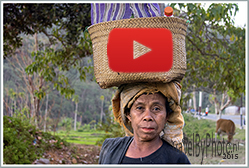
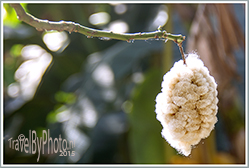
Away from the hustle and bustle of the airport we go for lunch. Then we drive to Moni(Map of Floris).
There is only one road that leads from Ende to Moni. It is a winding mountain road, going up and down. Under normal circumstances it takes approximately 2.5 hour to drive to Modi.
However, our traveltime to Moni will be a much longer. After a 1/2-hour drive we pass some huge rocks, almost as big as a House and we have to stop. There are road works. Bulldozers and excavators are working against a steep mountain slope. They pulverize big rocks and make the mass of stone slide down the mountain. It gives a huge noise and causes large clouds of dust. Our route is blocked. The road is closed to all traffic. We hear that the road will be closed until 6 pm tonight. There is no alternative. This means 2 hours waiting before we can move forward.
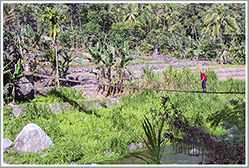
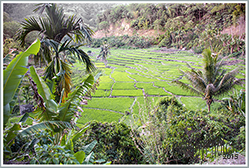
There is a long queue for the roadblock. Motorcycles, mopeds, passenger cars, trucks vans etc. Aside the road are some stalls with drinks and food. The people here are clearly prepared. After about 2 hours the road opens again. We resume our journey together with the dozens of cars and hundreds of mopeds on both sides of the roadblock, who as we have, had to wait, now want to drive as quickly as possible and all at the same time away from the roadwork spot.
Augustino is Catholic. He is cheerful and quickly understands what we like.
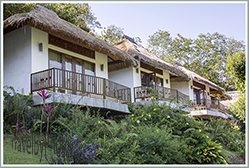
En route he shows all kind of interesting details of nature and vegetation here. Like the kapok tree (kapok, yes frequently used in Holland in the early times to fill pillows and mattresses and so on), the macadamia- and the cashew tree. On sheets beside the road clove is beeing dried. We make small walks on bumpy bridges. The people we meet are very friendly. Beautiful rice fields!
Flores makes a great first impression. The hills are green. An old lady who comes to us is quite excited. She wants us to take a photo together. Not long after a few others come running to us as well. They want to be put on the picture too. At the beginning of the evening we will arrive at our hotel: The Kelimutu Crater Lakes Ecolodge in Moni. Agustino takes us to a restaurant nearby that has just opend. The restaurant is owned by friends of him. Tasty food and good rasta music. The alarm clock is set for 4 am Tomorrow morning to wake us for a visit to the Kelimutu Volcano( map of Floris)!
Before dawn our alarm clock awakes us. At 4 am we are ready to go. It is an hour drive over a winding mountain road to the entrance of the Kelimutu national park. We stop at the car park and step out of the car. From here on it is a 30-minute climb to the top of the mountain. A heavy walk but we survive with a bit of hyperventilating and an extra stop. We are lucky. It is almost cloudless;so it promisses to become a spectacular sunrise.
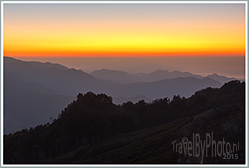
At the top of the mountain is a view point. The view is beautiful. There are three crater Lakes. They are farther apart than the pictures that we have seen in the brochures suggest. Two lakes in front us, one behind us. The 3 crater Lakes have different colors, black, turquoise and dark brown. No one can explain why the Lakes constantly change color. The locals believe that the souls of the departed rest in these lakes; in the black more old people, in the turquoise more young people and in the dark brown more ... the bad guys. More likely is that by the course of the years the colors of the Lakes change by its minerals in the bottom of the crater.
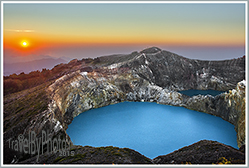
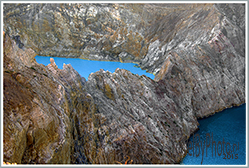
We are ample of time to the sunrise. The colors of the lakes we find less spectacular than we expected but it was a very special experience that we had not want to miss.
We go back down to meet the local guide who will acompagnie us on a hike along various traditional weaving villages. The path runs, quite steeply down. Lovely people in the villages. Great nature. We climb over bamboo bridges (without handrail). We enjoy the beauty of a impressive waterfall.
Eventually we return to our hotel where we get a fine breakfast. We really need that that after a early wake-up call and the heavy trials this morning. Fresh fruit, omelette, tea. Too bad we only have 1 night in this hotel. It is a fine place, surrounded by beautiful nature.
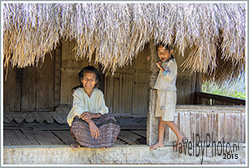
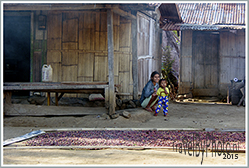
After breakfast we depart back to Ende again. For this, we must drive the same road as yesterday, so that means we have to go again along the road works. According to Augustino the road will be open to traffic between 12:00 and 1:30 pm. We must therefore pass the road works in that time frame. Very important because after 1.30 pm the road will be closed again till 6:00 pm. Something to keep an good eye on.
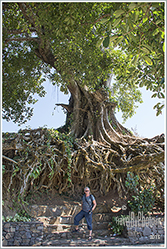
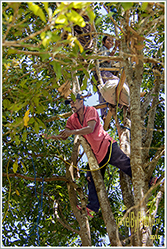
Luckely we still have time to visit two villages. One village is less interesting, looked more like an open air museum where no one really lives. There are also quite a lot of new houses. The other village, Liodorp Saga is very nice, although we do not see many people.
Here grow Cocoa beans (the seed in the fruit of the cocoa trees), coffee bushes, banana trees, clove trees, papayas and sweet potatoes. The flowers smell great.

We meet the wife of the head of the village who is excited to explain us everything we want to know about the village and the vegetation. She shows us the House where they live and tells that there has been a large ceremony for the ancestors 1 week earlier. Family members from all over the world visited the ceremony. Even familymebers from Manila visited the village. A very impressive tree with huge aboveground roots stands at a prominent place in the village.
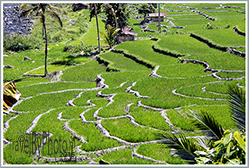
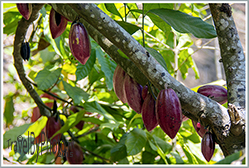
The visit took some time so now we really have to hurry towards the roadblock. We are on time but when we arrive on the spot it appears that a large macademia tree from the mountain has fallen down on the road. It has to be removed so we still have to wait for another 50 minutes. Finally we drive on to Ende. The road leads us along beautiful rice fields and Chile plants.
It's hot! We arrive in Ende, Satar Mese Guesthouse. It's a pretty boring hotel. There would be Wi-Fi but that is not there.
In the afternoon we visit downtown Ende, there is a market. Nice but not very special.
We slept well. Breakfast was a bit odd; 2 x a box, very cold, from the refrigerator. A factory roll and a very cold pie and a kind of jelly pudding. We kept a lot of leftovers!
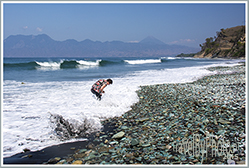
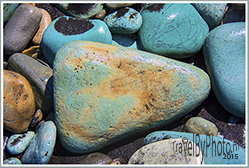 We leave the hotel in Ende and drive direction Riung (map of Floris). The first part we drive along the coast. Nice high waves! After half an hour we see to our left hand the famous "Blue Stone Beach".
We leave the hotel in Ende and drive direction Riung (map of Floris). The first part we drive along the coast. Nice high waves! After half an hour we see to our left hand the famous "Blue Stone Beach".
Very special that the Black Beach in parts is littered with blue, green and purple rhinestones. The stones are collected by the locals to sell to traders who resell them again to the trade on Bali. They get RP 25,000 per bag. These stones are used for decoration of houses, buildings and especially swimming pools.
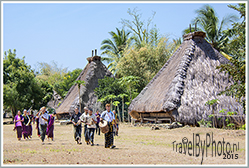
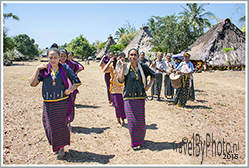 Of course we have also collected a few beautiful stones. Nice to pick some nice ones out of the water. When the water washes over the stones they even get more beautiful of color! We walk around for half an hour. The pockets of Ingrids shirt are getting heavier and heavier by all her collected stones ... Not so smart considering our next flight when we can only take 10 kg luggage with us! Eventually even Ingrid stops with collecting the stones. In stead she takes a few extra photos. Nice place to stroll around here.
Of course we have also collected a few beautiful stones. Nice to pick some nice ones out of the water. When the water washes over the stones they even get more beautiful of color! We walk around for half an hour. The pockets of Ingrids shirt are getting heavier and heavier by all her collected stones ... Not so smart considering our next flight when we can only take 10 kg luggage with us! Eventually even Ingrid stops with collecting the stones. In stead she takes a few extra photos. Nice place to stroll around here.
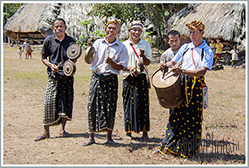
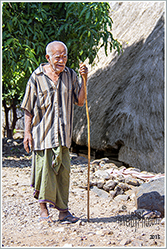
En route another (already announced in advance) surprise. We will visit Tutubadha, one of the last villages where the traditional Nagakeo-houses still exist. We will be welcomed with traditional music, dance and a meal.
We are curious. En route the head of the village has been informed what time we will arrive. It's a long drive before we arrive.
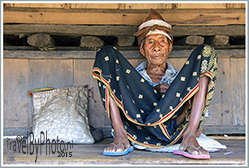
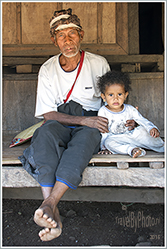
In Tutubadha we are met by a welcome Committee. We are the only guests. The children sing songs of Bob Marley. They find our visit extremely exciting. Older men make music on traditional instruments an the women are dancing at the music.
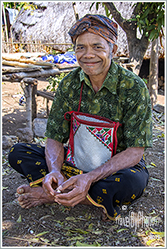
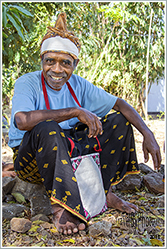
The English teacher of the children is also our guide in the village. The houses are situated in a square to a large wide open field. The houses are very special, all of wood and large roofs of grass that almost hit the ground. We get woven scarves hanged around our necks with the colors of this area.
The children perform a dance for us. Well practiced, but also very messy. Makes it even more fun. They have a "1000 questions" for us, but when they get the opportunity to ask most find it to scary to do that.
Then we get a meal offered. We sit on the porch. There is rice, fish, something that resembles spinach but tasts very bitter. The food is served in wicker baskets. It strikes that it is relatively cool on the verandas of these houses. That is convenient, because it's quite warm today!
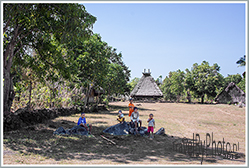
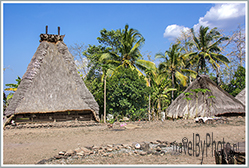 After we have eaten we walk around some more in the village. The children now walk hand in hand with us. The young people are pulling away from the villages as Tutubadha, but there are still older people who live here and are busy in their homes. An old man is called ' grandfather Petrus ". We are always amazed at all the Dutch names that the people have here in these ancient villages.
After we have eaten we walk around some more in the village. The children now walk hand in hand with us. The young people are pulling away from the villages as Tutubadha, but there are still older people who live here and are busy in their homes. An old man is called ' grandfather Petrus ". We are always amazed at all the Dutch names that the people have here in these ancient villages.
We take a lot of pictures. Some children and elderly also have a camera/phone. Everyone wants to take a picture together withe us! We offer the people some Kretek cigarettes which are clearly popular with the men of the village! They are very wanted. On our turn we get betel nuts offered but - sorry - that is a custom we prefer not to do.
Beautiful village with a cheerful people. The rear House on the field is the most important of the village. It is the House of the head of the village. This old man is 121 years old according to the villagers! We can't believe that, but he is really very old for sure. He also likes to smoke a cigarette so we offer him a few. Many group photos are made of us together with the villagers. After we have given the teacher 2 soccer balls, a bag of candies and some balloons for the children we leave again.
After we have left Tutubadha we continue our wonderful ride through the deep valley to Riung, on the North coast of the island.

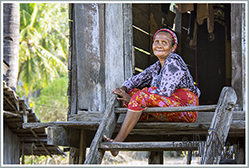
It still is a 2.5-hour drive from Tutubadha to Riung. But it is a beautiful ride. A very narrow road with lots of potholes. It's a tricky drive for Augustino. We drive between the palm trees, tamarind and coconut trees. We make a stop in "just" a village. Often such unexpected stops are the best. Very friendly people and nice houses. Some houses resembles a Sulawesi house, our guide explains. The oldies are so cozy sitting together in the evening sun.
We drive on to a viewpoint from where we see many islands. Tomorrow we will visit the islands by boat.
Finally we arrive in Riung. We go to our hotel, the Pondok SVD Guesthousel; It's very simple. We take a cold drink on the veranda in front of our room.
Augustino comes along with the skipper of the boat of tomorrow. He explains to us what we need to take with us; towel, snorkel and diving glasses, a t shirt as protection against sunburn, water shoes and a hat.
He apologizes that he has only a fairly simple boat, but we don't mind of course. We very much look forward to the boat trip!

After breakfast, early in the morning, we walk to the harbour of Riung about 500 metres from the hotel. Today we go by wooden motorboat to a nearby island. The area of Riung makes up a national park called Pulau Tujuh Belas (Seventeen Islands)
It will be a snorkeling trip and relaxing day on pristine beaches today. Riung is one of only few places in Flores with access to white sand beaches. The ' 17 Islands Marine Park ' is known for its corals and colourfull fishes. Some of the islands are just rocks sticking out of the sea but the large ones are hilly and fringed with mangroves, where we will see thousands of flying foxes hanging in colonies in the mangrove trees.
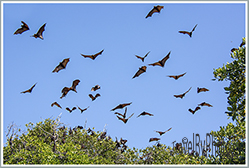
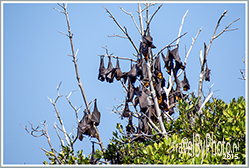
We are excited. The weather is, like every day, beautiful. In the port we are met by the skipper and his 2 helpers. With his simple boat we fare to the marine park. We enjoy a delicious trip on the water. There is a nice breeze. We flow away well. Every now and then we are splashed wet by the waves. Delicious all the dancing on the waves!
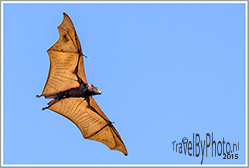
First we are going along the island Ontoloe. In the mangrove forests of this island lives a colonie of hundreds of flying dogs. Flying foxes they call them here. Their wings can span more than 1 meter.
We can see them clearly hanging in the trees. The Guide/skipper makes a lot of noise. It scares the flying foxes so they start flying. You can imagine them thinking ... oh no yet some new annoying tourists that wake us up so they can see us fly. And ideed we do and it is a spectacular sight to see how these beasts are flying around the island. What a huge numbers! The sun shines on their wings and you can see the lines of the skeleton, as if the wings are completely translucent. Their natural enemies are the Eagles (that we have indeed seen en route) and ... mankind! Well, they can rest assured that we dont plan to eat them!
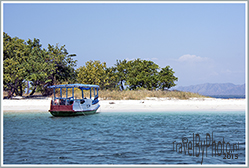

We sail further to another island with a delicious white sandy beach! We jump out of the boat into the water and go for some snorkeling. It takes some time getting use to our new diving glasses, but after a while it goes fine. Super special, to dobber here in that great big tropical aquarium! All those whimsical shapes. The small cobalt blue fish and huge Starfish in the water. We don't know exactly how many degrees the water here is, maybe 27 degrees? In each case an ideal temperature. You do not have to get used to the temperature of the water and yet it is cool and refreshing. Very special to see all these beautiful corals.
If we have hoisted ourselves back on the boat, it appears that the crew, while we were in the water, have prepared a delicious lunch for us. Salad, rice, rice noodles, little bananas, really delicious. After lunch we swim a little more before we leave for a visit to another beach.
Again snorkeling and swimming. The underwater world here is truly beautiful. We enjoy all the beauty. Starfishes with red-brown thick dark dots, the coral. Much purple down below us and yellow/brown. Fish in lots of colors. Also very small black/white fish, a kind of zebra fish.
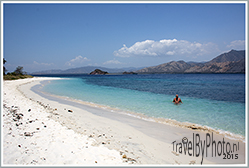
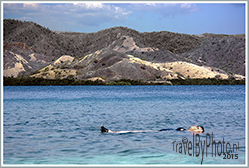
One little fish is chasing another. Everything seems to dance and to wave under the water. You lie in the water look down and seem to fly over that unique underwater world. Small pink fish swimming towards you and look at you. Romantic too; stretched out on the water facing each other and holding each others hands. Experiencing all the beauty together. It is not easy to leave the water. We like to hold on to such a nice experience. But that that is not only wise as Jan-Arend soon will find out.
When we leave the water to enjoy the BBQ Jan-Arend feels very sick at his stomach. Clearly an issue of too much sun, too much seawater and perhaps a bacterium? Annoying!
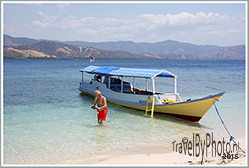
Still, we had a great day. We sail in about 40 minutes back to the port and to our hotel. Jan-Arend goes to bed. Hope his stomach problems will be over fast.
Ingrid her legs are burned heavely. Although she kept on her shirt in the water she insufficient realized that the back of her legs stayed open in the sun.
About today we can be brief. Jan-Arend still vomits in the morning. He remains heavely sick. We drive to to Bajawa (map of Floris), located at 1200 metres altitude, surrounded by volcanoes. Along the way we stop a few times but Jan-Arend wants to go as fast as possible to the hotel Happy Happy. A small, simple homestay. The owners are Dutch.
Jan-Arend sleeps all day and evening. Fortunately, there is Wi-Fi in the hotel so that Ingrid could spent the time sending some text messages to the homefront. She even could read a local dutch newspaper online. Regarding the condition of Jan-Arend we will problably have to change plans. The plan was to make a long hike tomorrow and spent the night in a hut. But we doubt if Jan-Arend will be in the right condition tomorrow to undergo such a heavy physical load.
Jan-Arend is feeling a little better. He eats a sandwich but still feels very flabby. We consult Augustino. The local guide that would accompany us in the planned trekking has already arrived. We agree to skip the trekking. Instead, we explore the area by car and visit 2 very interesting villages. Good plan.
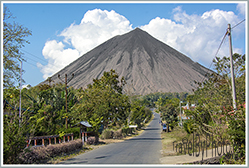
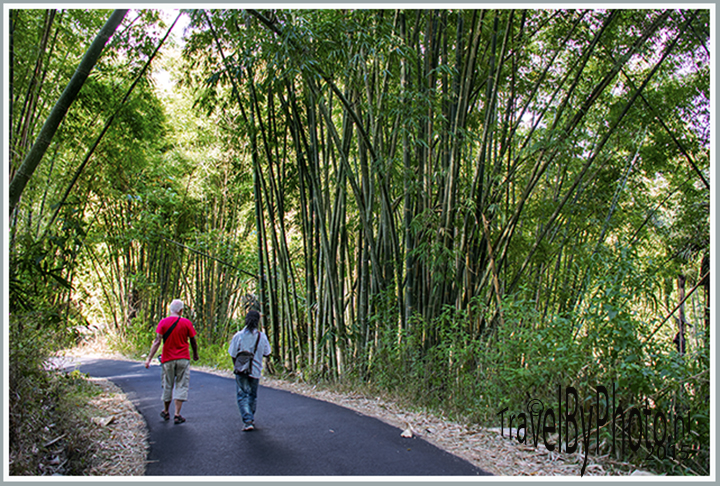
The local guide stays with us. He is very nice. A rastaman. He tells a lot about the habits and traditions of the Ngada; the traditional population that lives here. We drive through a huge bamboo forest where the tribes of the bamboos are extremely long. Impressive!
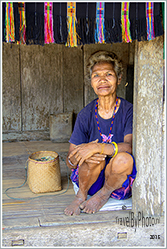
 In the background looms the Gunung Inerie volcano. the Gunung Inerie is with its height of 2230 metres the highest volcano of Flores.
In the background looms the Gunung Inerie volcano. the Gunung Inerie is with its height of 2230 metres the highest volcano of Flores.
We arrive at the first Ngada village; the village Luba. Very authentic; the peaople still live in the village as in the olddays. The people are very welcoming. Some houses have symbols at the top of the roof such as a doll or a little cottage. They really fancy the use of the betel nuts here. Everywhere men and women with red around the mouths and red teeth.
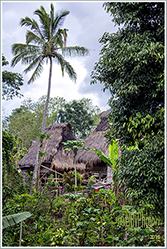
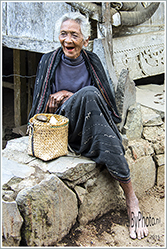
The guide explains why the houses here are so expensive. It is not only the material to built the house that costs money, but also the necessary rituals to inaugurate the house swallow a lot of money. Many Buffalo, horses, pigs and chickens must be sacrificed at such an occation.
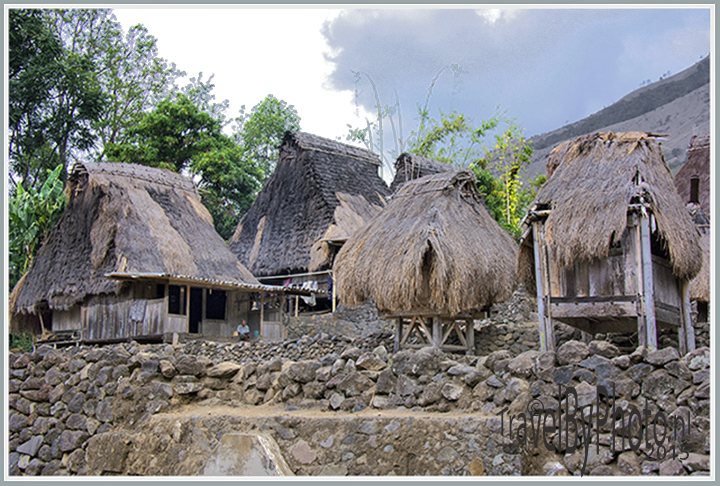
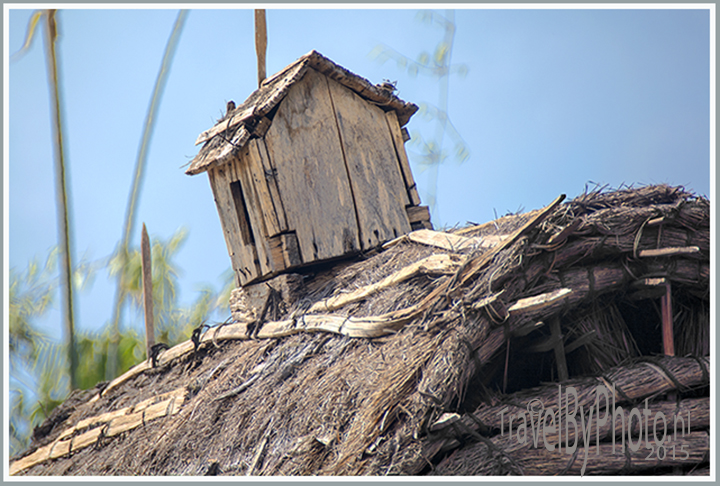
One House has been consecrated yesterday . The leftovers of the offerings are presented to us but eating pig here would probebly not be the best medicine for Jan-Arends stomach so we pass for the honor. It's a nice sight. The people eat out of home made baskets. Especially the oldies sit on their porch and observe us with interest and curiosity.
One of the families invites us for a cup of tea. The old lady wants to know how many children we have and then she also wants to see a photo of our granddaughter. Jan-Arend shows her a photo on his phone. She loves it; She wants to kiss the photo on the phone. Cute! She herself has 16 grandchildren!
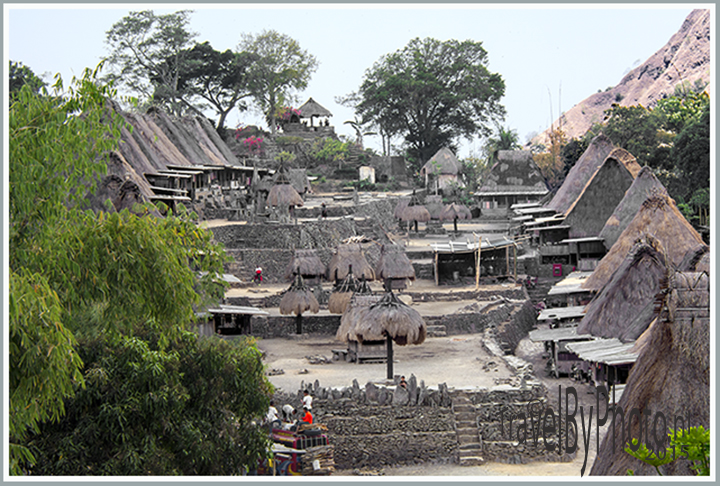
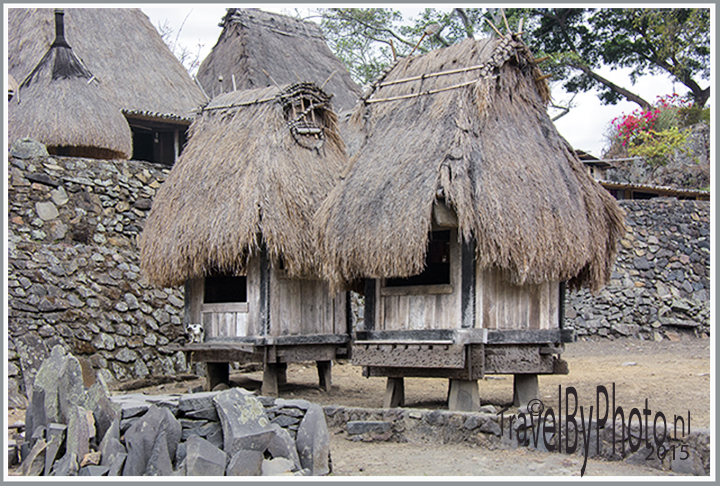
The visit is very enjoyable. We have brought some sweets for the little ones, some notebooks and pens for the school-age-children and some kretek cigarettes for the adults. We buy a used betel nut box from our hostess, the old lady. Children are cleansed of lice by their parents. The houses are solid and decorated with symbols. Rugs hang over the verandas. It's a pretty wide village with large open spaces for the sacrifice. Very well visible in the Centre of the village are the Ngadhu and Bhag, couple of shrines.
The function and significance of the Ngadhu and Bhag is multiple, but basically they symbolize the abiding presence of the ancestors. The Ngadhu is male. The trunk is decorated with carvings and is finished with a warrior-like figure. The Ngadhu symbolizes ferocity and virility.
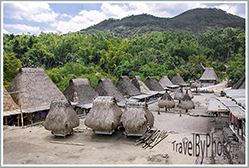
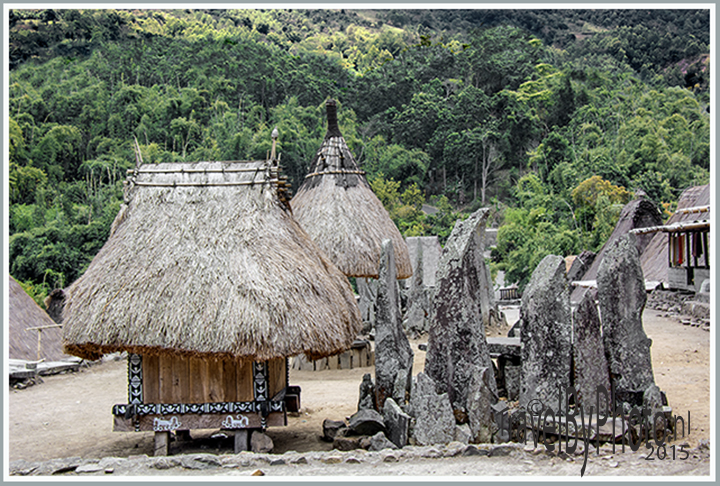
The Bhaga, embodies the female ancestor. It is a small hut with a thatched roof, that seems to be a miniature of a traditional House. It symbolizes the sanctuary of the House and the female body. The Bhag offers enough space for 1-2 people to perform their rituals for their female ancestors.
The "couples" are generally linked with a particular family in the village. The ancestors reveal in dreams of relatives instructions when to rebuild the monuments according to established patterns. This then comes with the necessary ceremonies during which some Buffalows are slaughtered. The horns of the animals are taken to the huts of the Ngadhu.
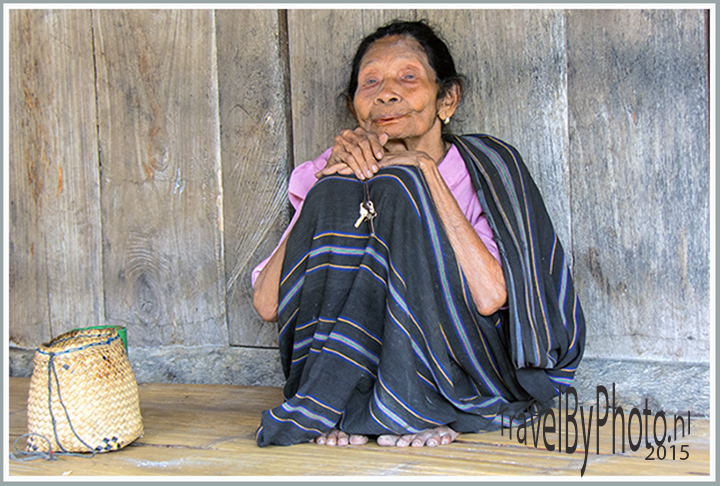
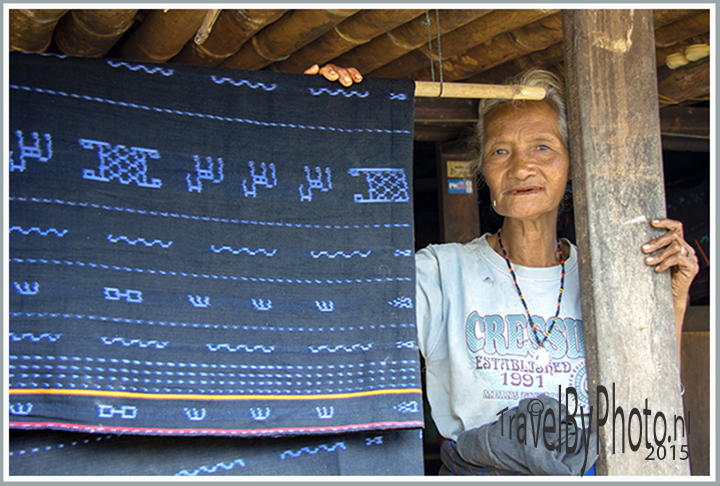
The 2nd village that we visit is called Bena. Bena is the most well-known Ngada village. The village consists of two parallel rows of traditional houses with high thatched roofs.
All very uncluttered. In the center of the village gadhu couples and bhag shrines again.
Another clear characteristic of the Ngada culture, are the megalithic formations in the Centre of the village. In Bena these are very impressive! Megaliths serve as linking agent to the supernatural world and to communicate with the ancestors, often by sacrificing animals. There is a stone altar. In addition, there is a huge pile of flat stones, called Lenggi. It is the place where the various clans of the village deal with their legal disputes.
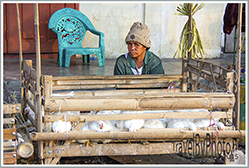
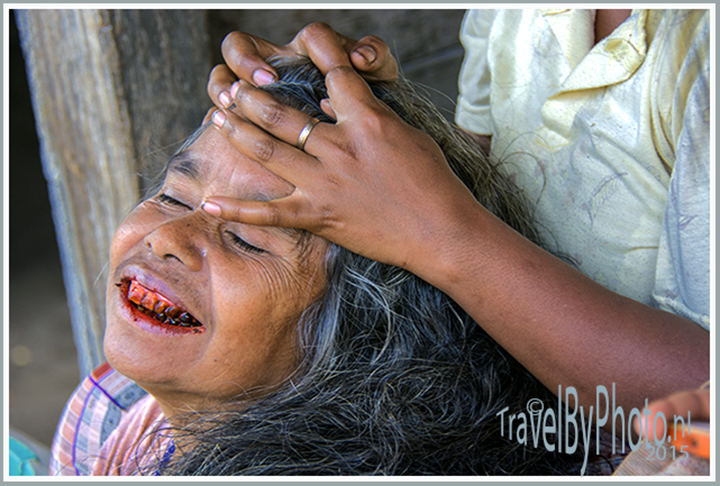
The houses in Bena are usually decorated with skulls and horns of water buffaloes and pig jaws that were sacrificed at various ceremonies. The village is pretty clean, but when you look at the dishwashing water that is used to "clean" the dishes.... that water is really extremely dirty!
Women do a game with a kind of marbles. Chickens run around and coffee beans are drying. Our son works in the chocalate industry. Therfore Ingrid is picking up a great cocoa bean for home.
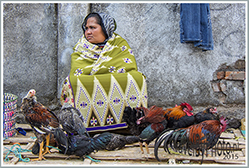
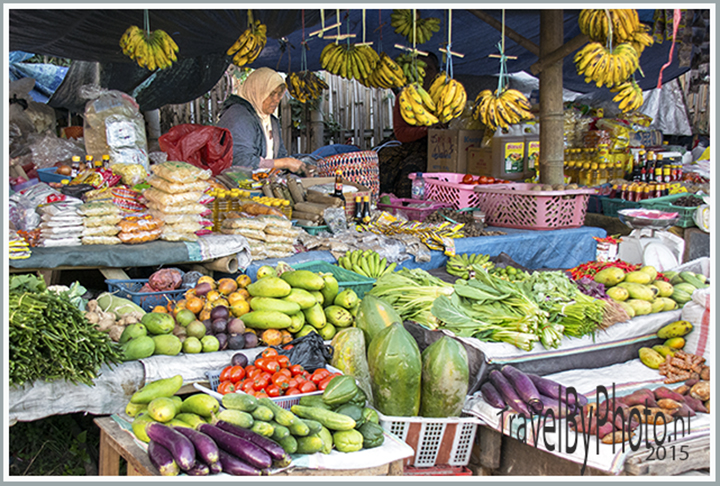
We don't miss our hike; this is really a very nice alternative/excursion.
After our visit to the villages we have lunch. Then we move to another hotel. Happy Happy is fully booked. They have no room for us anymore because we had actually had to sleep in a hut elsewhere related to the draw. We move to the Sanian hotel. We have a room that is 2 x as large as the previous one.


After the meal we relax in the room. In the afternoon we go to the market. Fish, vegetables and chickens. The vegetables are here again devided in neat little portions. Jan-Arend is still not completely completely recovered and has a belly that makes sounds like a rumbling volcano.
A moderate breakfast is served in this hotel. Some bread and no orange juice or another drink. Today we drive direction of Ruteng. We start driving early in the morning at 7.30 am because somewhere along the way is yet again another road block.The roadblock is lifted from 12.00 noon till 1 pm. When we fail to pass in the given hour we will have to wait till they stop working, and that will be around 6.00 pm..
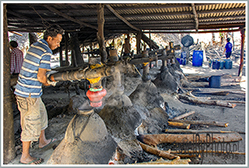
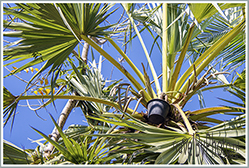
It is quite a long drive but it is a beautiful ride through a green, mountainous area with many clove trees. In the beginning, the imposing volcano is still seen from every angle in the background. Large variety of trees; the one even more beautiful than the other. The trees are sometimes covered by parasitic plants. At some places it makes a somewhat lurid scenery.
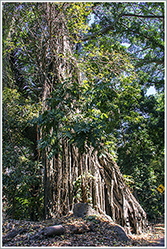
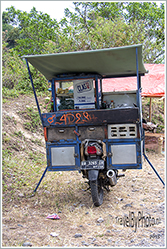
Augustino tells a lot interesting facts. We stop at a cashew nut tree. Nice to see how the the nuts grow. Now you can also better understand why they are so pricey In Netherlands. Such a large fruit (bats love them) and then 1 silly little nut. We stop at a beach with very black sand. Yet it is of the same composition as at home. Strange. There are some fisherman's cottages and some fishing boats.
In Aimere we make a stop at a distillery. One makes arak here from the juice of the lontar palm tree. They show us the process of the preparation of the arak. No fun to work here! Climbing in that tall trees to collect the juice is hard and dangerous work and the fires are very hot! Our health and safety authorities would make a lot objections about how one have to work here.
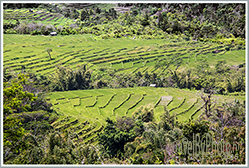
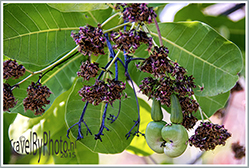
Beautiful views on the rice terraces. There are many square mats of about 2 by 2 metres woven here. They are used as walls of houses. We drive along the Rana Mese lake. No swimming stop here; it is said that there are crocodiles here. We hear a lot of bird sounds. Then we reach the place of the road block. It is just after noon and they are already busy freeing the road. There are motors with mini stalls on the back. You can buy the necessary consumptions there during waiting time.
Eventually we arrive at our hotel in Ruteng (map of Floris); Santa Maria Berduka Cita. It's actually a monastery with guest rooms.
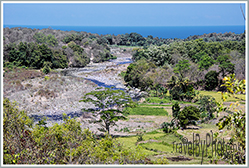
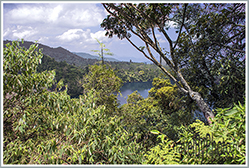 The hotel is run by the nuns of the monastery. We get a room. If we want to leave we can't find the key. Ingrid asks at the reception if the key is still there but no the key is not at the reception. We keep on searching for a while before asking the guy in the front desk if he wants to close the door for us. No, says the boy; the people who have left this morning took the key with them and there is not a copy. Well what to do now? Nuns/monastery or not, we don't like to leave the room without locking it. Therefore we ask and get a new room. We pull us back in the new room for a moment; Jan-Arend can participate with the whole program but still feels sick.
The hotel is run by the nuns of the monastery. We get a room. If we want to leave we can't find the key. Ingrid asks at the reception if the key is still there but no the key is not at the reception. We keep on searching for a while before asking the guy in the front desk if he wants to close the door for us. No, says the boy; the people who have left this morning took the key with them and there is not a copy. Well what to do now? Nuns/monastery or not, we don't like to leave the room without locking it. Therefore we ask and get a new room. We pull us back in the new room for a moment; Jan-Arend can participate with the whole program but still feels sick.
Later in the afternoon we walk tot the city. Many children around us. They have a lot of questions for us like how we are and where we come from ... . It is a assigment of school. The children want to practice their Englisch. All very friendly, but they are with too many.... Jan-Arend takes a cup of chicken soup in a small restaurant and feels a lot better after finishing his plate.
The Centre is not very impressive. More of the same So we return to the hotel. In the evening we have diner around 7 am. Breakfast is from 6:00 to 8:30 a.m. and in the evening you need to be back inside the hotel at 9 p.m. It is a monastery ...
After breakfast we we leave around 8 am. Augustino shows us the Cathedral of Ruteng. The old one, and the new one that is even bigger. We are not really that interested but okay. Further, we visit a traditional Manggarai House. Interesting but very isolated situated between new houses so it loses a bit of its charm. It becomes a kind of a museum.
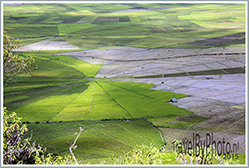
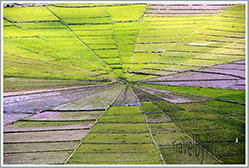
We pass through several villages with very friendly people and make a stop at a viewpoint overlooking Ruteng.
Then we drive 17km west from Ruteng to Cara Village. This is the place where the most famous rice fields of Floris are best seen. With their round, spider-web structure, these pieces of land are unique eye-catchers on Floris and date from long before the time of wet-rice cultivation. The ancestors of the Manggaraian people that live here grew dry rice, corn, and tubers in the fields. Every village used to own several fields.
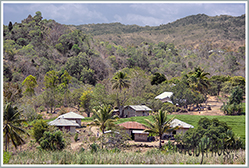
The division of a new fields was guided by the tu’a teno, the Lord of the Land. This traditional leader had the authority over the distribution of the land, the rituals and ceremonies related to the agricultural cycle. Every family of a community had the right to work a certain piece of land. Depending on the family’s size, the head of the family places a certain number of fingers on a pole. The distance between the fingers was marked on this pole. From these two points, lines were drawn to the outer circle, defining the size of a family’s land. These pie segments were called moso, which means ‘hand’ in the Manggarai language.
The spider web fields are beautiful from above the hill. You will need to climb to the top of the Hill. Quite a climb. Jan-Arend has not yet enough breath to climb up all the way. Therefore, Augustino and Ingrid together move on to the top. A beautiful sight, the round fields down there. Partly green, already harvested. Fascinating!
Fine that it is no rain season now because else it would have been hard to reach this place.
The trip today leads over beautiful mountains. Partly this area is a national park. Sometimes it's a bit misty. Lots of hairpin turns too. School children wave at us. We stop here and there to enjoy the beautiful surroundings. We also stop at a ricefield where farm workers are at work. They plant new ricel plants. When harvesting, the rice straw is cut off. The leftover straw is for the livestock. Very heavy work in the killing heat! Sometimes there is a Chinese buffalo, a simple machine for plowing that we have also seen in Sri Lanka. Nice to see what a rice plant really looks like!
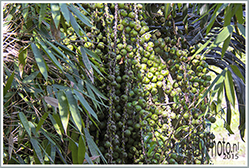
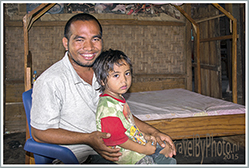
It is something with what we are confronted with time and time again this trip: all the spices where we are so used with in Holland can be seen here at the beginning of the processing process, The cocoa, the pepper, the coffee, rice, the cashews, the kapok, the clove and so on. What a wealth of crops!
At the top of the mountain we can see the sea and the islands in the distance, We make a stop at a tree called the rasta's tree We can unsterstand the namegiving of the tree. Long slings of fruit are hanging straight down. We arrive in Labuan Bajo (map of Floris). We will be deposed at our hotel Bajo Eco Lodge.
We say goodbye to Augustino. We drink a juice with him before he leaves us and re-unite himself with his family (who lives here too). He certainly contributed to the nice time we had on Flores. Unfortunately, we lost his address because otherwise we could recommend him as a guide and we could send him photos.
The hotel is great. A beautiful spacious room with a large balcony, beautiful bathroom, wifi, and sea view. Very plaesant to stay here. There is also a nice swimming pool. Ingrid takes a dip, and in the evening we have diner in the hotel. Fortunately, Jan-Arend's is fully recovered. Important because tomorrow we will make a unique trip through the Komodo National Park, one of Indonesia's most beautiful areas! We look very much forward to that!